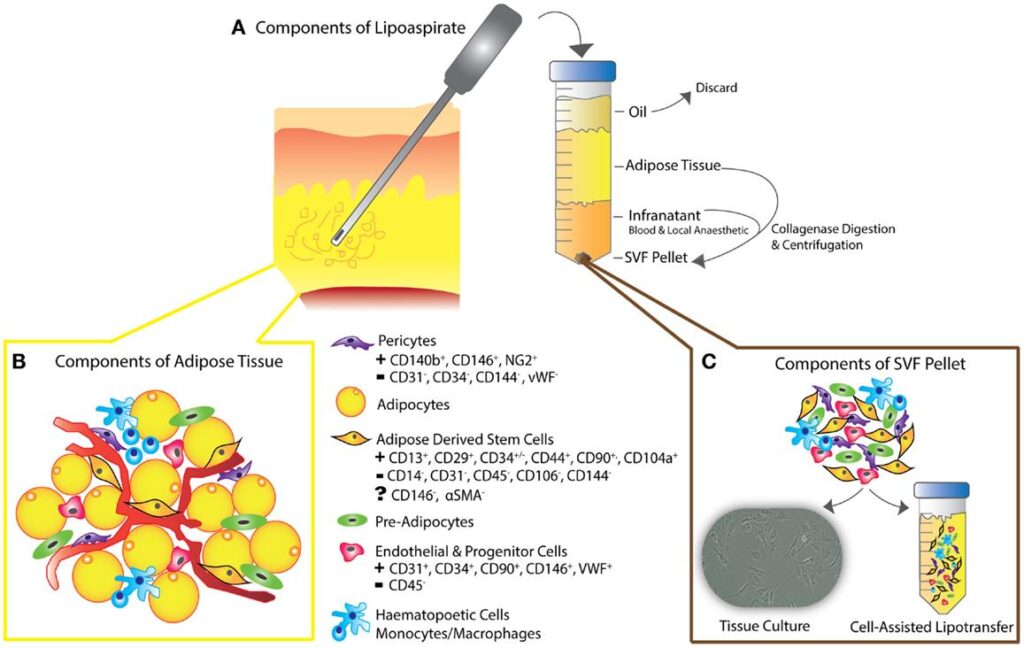Revolutionary Insights into Aging and Fat Tissue Dynamics
A recent study published in Science has made a remarkable discovery regarding the impact of aging on fat tissue development. Researchers have found that as we age, unique adipose progenitor cells emerge, leading to an intensified process of adipogenesis—the creation of fat cells. This revelation not only clarifies the intricate relationship between aging and fat accumulation but also prompts critical inquiries about its effects on metabolic health and obesity among older adults. Given that obesity remains a pressing global health issue, this research emphasizes the urgent need for a comprehensive understanding of how our bodies evolve with age, potentially guiding new approaches for managing age-related metabolic disorders.
New Discoveries in Age-Associated Adipose Progenitor Cells
Recent investigations indicate that aging leads to significant changes in fat tissue composition, resulting in the formation of distinct populations of adipose progenitor cells. These age-specific progenitors demonstrate enhanced abilities for adipogenesis compared to their younger counterparts. Researchers have pinpointed unique markers and gene expression patterns that differentiate these cells from those present in younger individuals. The implications are profound: rather than merely experiencing a decline in metabolic function with age, our bodies activate specific cellular pathways that promote increased fat storage and shifts in energy balance.
The functional ramifications of these changes could significantly affect health outcomes for older adults. Key factors include:
- Increased mass of adipose tissue: This can lead to conditions associated with obesity.
- Diverse metabolic responses: These may influence insulin sensitivity and glucose management.
- Potential connections to inflammation: Which could worsen chronic illnesses.
This evolving research landscape underscores the importance of understanding these dynamics as it may lead to targeted therapeutic interventions aimed at addressing age-related metabolic challenges. Continued exploration into the molecular mechanisms governing adipose progenitor cell behavior throughout aging is essential.
Deciphering Active Adipogenesis Mechanisms Among Older Individuals
The latest findings reveal that as people grow older, the processes involved in forming new fat cells become more pronounced due to specific adaptations within adipogenic pathways. These adaptations allow for more dynamic remodeling within fat tissues—an aspect often overlooked when considering aging populations. The study draws attention to how differences between younger and older adults’ mechanisms can contribute not only to variations in body composition but also pose unique metabolic challenges during later life stages.
The results suggest that older individuals possess a distinctive array of adipogenic factors, which regulate their progenitor cell activities differently than those seen earlier in life. Notable contributors include:
- Aging-related growth factors: Stimulating both cell division and differentiation processes.
- Mediators linked with inflammation: Capable of either promoting or inhibiting lipid storage mechanisms.
- Differentiated hormonal signals: strong>This influences how effectively adipose tissues metabolize energy.
This detailed comprehension surrounding active adipogenesis lays groundwork for developing focused strategies aimed at mitigating issues related to metabolism as one ages by identifying specific pathways prevalent among older adults—opening doors toward innovative therapeutic options against obesity-related complications within this demographic group.
Strategies for Enhancing Adipose Health Among Seniors
The significance behind recognizing distinct populations emerging from aged-associated changes highlights crucial considerations when devising strategies intended towards fostering healthier fatty tissues among senior citizens today’s healthcare professionals should prioritize several recommendations including:
- < strong>Bespoke Nutritional Approaches: strong > Crafting dietary plans rich with anti-inflammatory ingredients can assist managing body composition while promoting healthier forms’ development over time . li >
- < strong >Consistent Exercise Regimens: strong > Incorporating strength training alongside aerobic workouts enhances functionality amongst existing precursor cells thereby improving overall lipid metabolism . li >
- < strong >Hormonal Regulation Strategies : strong > Addressing hormonal fluctuations associated with advancing years optimizes cellular activity leading improved general wellness . li >
- < strong >Ongoing Monitoring Practices : Regular evaluations concerning both structure & function provide actionable insights facilitating proactive management efforts targeting elderly patients’ well-being . li >
ul >
< p > Moreover , exploring cutting-edge treatment modalities tailored specifically towards characteristics inherent within aged – related precursors proves vital ; potential avenues might encompass :
< / p >< strong>Treatment Methodology< / th > th > < strong>Description< / th > th >
< / tr >< /thead >
< str ong >Stem Cell Interventions< / td > td > < str ong >Employing stem cells derived from aged sources regenerates healthier fatty tissues.< / td > td > < str ong >Genetic Modifications:< /td> Edit genes influencing lipocyte formation enhancing overall functionality.< /td > Biosignature Discovery:< /td> Select biomarkers tracking precursor vitality across senior demographics.
td >Final Thoughts on Aging’s Impact on Metabolic Health
The identification emergence distinct types’ precursors linked directly correlates interplay between growing old & developing new fats reshaping perspectives surrounding maintaining optimal wellness levels throughout lifespan As scientists delve deeper unravel complexities underlying phenomena implications regarding weight gain coupled alongside various disorders become increasingly apparent This fresh viewpoint emphasizes adaptability exhibited by human body’s ability respond changing circumstances paving way future treatments combating ailments stemming from excess weight As advancements continue unfolding discoveries stemming studies will likely yield transformative solutions ensuring better quality living standards even amidst inevitable passage time .
